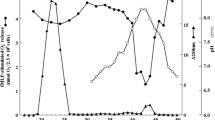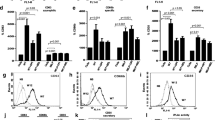Summary
The chemoattractants, N-formyl-L-methio-nyl-L-leucyl-L-phenylalanine (fMet-Leu-Phe), complement C5a and platelet-activating factor (PAF), induce ß-glucuronidase release and aggregation and an increase in cytosolic Ca2+ [Ca2+]i in human neutrophils. We studied the roles of cAMP and cGMP in neutrophil avtivation, using their cell-permeant analogues, N6,2′-O-dibutyryl adenosine 3′:5′-cyclic monophosphate (Bt2cAMP) and N2 ,2′-O-dibutyryl guanosine 3′:5′-cyclic monophosphate (Bt2cGMP) and the NO-containing compounds, sodium nitroprusside (SNP), 3-morpholino-sydnonimine (SIN-1) and its prodrug, molsidomine (SIN-10). Bt2cAMP, Bt2cGMP, SIN-1 and SIN-10 but not SNP inhibited exocytosis induced by fMet-Leu-Phe. Superoxide dismutase potentiated the inhibitory effect of SIN-1. Bt2cGMP and SNP potentiated C5a-induced ß-glucuronidase release, Bt2cAMP, KCN, SIN-1 and SIN-10 being ineffective. KCN partially reversed the stimulatory effect of SNP, and in the presence of superoxide dismutase, SIN-1 potentiated C5a-induced exocytosis. PAF-induced ß-glucuronidase release was not affected by Bt2cAMP, Bt2cGMP, SNP and SIN-1. Bt2cGMP was more effective than Bt2cAMP to inhibit aggregation and the increase in [Ca2+]i induced by fet-Leu-Phe at submaximally effective concentrations. C5a-induced rises in [Ca2+]i were not affected by Bt2cAMP and Bt2cGMP. Bt2cAMP but not Bt2cGMP inhibited the effect of PAF at submaximally effective concentrations on [Ca2+]i. Our data suggest (I) that Bt2cGMP and Bt2cAMP differentially modulate neutrophil activation, that (II) NO-containing compounds partially mimick the effects of Bt2cGMP on exocytosis and that (III) cGMP plays an inhibitory role in fMet-Leu-Phe- and a stimulatory role in C5a-induced ß-glucuronidase release.
Similar content being viewed by others
References
Beavo JA, Reifsynder DH (1990) Primary sequence of cyclic nucleotide phosphodiesterase isoenzymes and the design of selective inhibitors. Trends Pharmacol Sci 11:150–155
Bender JG, van Epps DE, Chenoweth DE (1987) Independent regulation of human neutrophil chemotactic receptors after activation. J Immunol 139:3028–3033
Böhme E, Graf H, Schultz G (1978) Effects of sodium nitroprusside and other smooth muscle relaxants on cyclic GMP formation in smooth muscle and platelets. Adv Cycl Nucl Res 9:131–143
Böhme E, Grossmann G, Spies C (1983) Effects of molsidomine and other NO-containing vasodilators on cyclic GMP formation. Eur Heart J 4 [Suppl C]:19–24
Burde R, Seifert R, Buschauer A, Schultz G (1989) Histamine inhibits activation of human neutrophils and HL-60 leukemic cells via H2-receptors. Naunyn-Schmiedeberg's Arch Pharmacol 340:671–678
Dewald B, Thelen M, Baggiolini M (1988) Two transduction sequences are necessary for neutrophil activation by receptor agonists. J Biol Chem 263:16179–16184
English D, Schell M, Siakotos A, Gabig TG (1986) Reversible activation of the neutrophil superoxide generating system by hexachlorocyclohexane: Correlation with effects on a subcellular superoxide-generating fraction. J Immunol 137:283–290
Ervens J, Schultz G, Seifert R (1991) Differential inhibition and potentiation of chemoattractant-induced superoxide formation in human neutrophils by the cell-permeant analogue of cyclic GMP, N2,2′-O-dibutyryl guanosine 3′:5′-cyclic monophosphate. Naunyn-Schmiedeberg's Arch Pharmacol 343:370–376
Ezekowitz RAB, Sim RB, McPherson GG, Gordon S (1985) Interaction of human monocytes, macrophages, and polymorphonuclear leukocytes with zymosan in vitro. Role of type 3 complement receptors and macrophage-derived complement. J Clin Invest 76:2368–2376
Feelisch M, Noack EA (1987) Correlation between nitric oxide formation during degradation of organic nitrates and activation of guanylate cyclase. Eur J Pharmacol 139:19–30
Feelisch M, Ostrowski J, Noak E (1989) On the mechanism of NO release from sydnonimines. J Cardiovasc Pharmacol 14 [Suppl 11]:S13-S22
Flavahan NA, Vanhoutte PM (1989) Mechanisms underlying the inhibitory interaction between the nitrovasodilator SIN-1 and the endothelium. J Cardiovasc Pharmacol 14 [Suppl 11]:S86-S90
Gryglewski RJ, Szczeklik A, Wandzilak M (1987) The effect of six prostaglandins, prostacyclin and iloprost on generation of superoxide anions by human polymorphonuclear leukocytes stimulated by zymosan or formyl-methionyl-leucyl-phenylalanine. Biochem Pharmacol 36:4209–4213
Grzeskowiak M, Della Bianca V, Cassatella MA, Rossi F (1986) Complete dissociation between the activation of phosphoinositide turnover and of NADPH oxidase by formylmethionyl-leucyl-pbenylalanine in human neutrophils depleted of Ca2+ and primed by subtreshold doses of phorbol 12,myrisate 13,acetate. Biochem Biophys Res Commun 135:785–794
Ignarro LJ, George WJ (1974) Hormonal control of lysosomal enzyme release from human neutrophils: Elevation of cyclic nucleotide levels by autonomic neurohormones. Proc Natl Acad Sci USA 71:2027–2031
Kang D, Tsuda H, Takeshige K, Shibata Y, Minakami S (1985) The role of Ca2+ and Ca2+-activated phospholipid- dependent protein kinase in degranulation of human neutrophils. J Biochem 98:1699–1706
Kaplan HB, Edelson HS, Friedman R, Weissmann G (1982) The roles of degranulation and superoxide anion generation in neutrophil aggregation. Biochem Biophys Acta 721:55–63
Katsuki S, Arnold W, Mittal C, Murad F (1977) Stimulation of guanylate cyclase by sodium nitroprusside, nitroglycerin and nitric oxide in various tissue preparations and comparison of the effects of sodium azide and hydroxylamine. J Cycl Nucl Res 3:23–35
Korchak HM, Rutherford LE, Weissmann G (1984) Stimulus response coupling in the human neutrophil. I. Kinetic analysis of changes in calcium permeability. J Biol Chem 259:4070–4075
Kuo JF, Shoji M, Kuo W-N (1978) Molecular and physiopathologic aspects of mammalian cyclic GMP-dependent protein kinase. Annu Rev Pharmacol Toxicol 18:341–355
Lad PM, Glovsky MM, Richards JH, Smiley PA, Backstrom B (1985) Regulation of human neutrophil guanylate cyclase by metal ions, free radicals and the muscarinic cholinergic receptor. Mol Immunol 22:731–739
Misra HP (1984) Inhibition of superoxide dismutase by nitroprusside and electron spin resonance observations and the formation of a superoxide-mediated nitroprusside nitroxyl free radical. J Biol Chem 259:12678–12684
Mueller H, Sklar LA (1989) Coupling of antagonistic signalling pathways in modulation of neutrophil function. J Cell Biochem 40:287–294
Pryzwansky KB, Wyatt TA, Nichols H, Lincoln TM (1990) Compartmentalization of cyclic GMP-dependent protein kinase in formyl-peptide stimulated neutrophils. Blood 76:612–618
Rapoport RM, Murad F (1984) Effect of cyanide on nitrovasodilator-induced relaxation, cyclic GMP accumulation and guanylate cyclase activation in rat aorta. Er J Pharmacol 104:61–70
Saran M, Michel C, Bors W (1990) Reaction of NO with O −2 . Implications for the action of endothelium-derived relaxing factor (EDRF). Free Rad Res Commun 10:221–226
Schindler R, Gelfand JA, Dinarello CA (1990) Recombinant C5a stimulates transcription rather than translation of interleukin-1 (IL-1) and tumor necrosis factor: Translational signal provided by lipopolysaccharide or IL-1 itself. Blood 76:1631–1638
Schmidt HHHW, Seifert R, Böhme E (1989) Formation and release of nitric oxide from human neutrophils and HL-60 cells induced by a chemotactic peptide, platelet activating factor and leukotriene B4. FEBS Lett 244:357–360
Schröder H, Ney P, Woditsch I, Schrör K (1990) Cyclic GMP mediates SIN-1-induced inhibition of human polymorpho-nuclear leukocytes. Eur J Pharmacol 182:211–218
Schultz K-D, Böhme E, Kreye VAW, Schultz G (1979) Relaxation of hormonally stimulated smooth muscular tissues by the 8-bromo derivative of cyclic GMP. Naunyn-Schmiedeberg's Arch Pharmacol 306:1–9
Sedgwick JB, Berube ML, Zurier RB (1985) Stimulusd-dependent inhibition by prostaglandins. Clin Immunol Immunopathol 34:205–215
Seifert R, Burde R, Schultz G (1989a) Activation of NADPH oxidase by purine and pyrimidine nucleotides involves G proteins and is potentiated by chemotactic peptides. Biochem J 259:813–918
Seifert R, Burde R, Schultz G (1989b) Lack of effect of opioid peptides, morphine and naloxone on superoxide formation in human neutrophils and HL-60 leukemic cells. Naunyn-Schmiedeberg's Arch Pharmacol 340:101–106
Seifert R, Wenzel K, Eckstein F, Schultz G (1989c) Purine and pyrimidine nucleotides potentiate activation of NADPH oxidase and degranulation by chemotactic peptides and induce aggregation of human neutrophils via G proteins. Eur J Biochem 181:277–285
Seifert R, Hilgenstock G, Fassbender M, Distler A (1991) Regulation of the superoxide-forming NADPH oxide of human neutrophils is not altered in essential hypertension. J Hypertension 9:147–153
Siciliano SJ, Rollins TE, Springer MS (1990) Interaction between the C5a receptor and Gi in both the membrane-bound and detergent-solubilized states. J Biol Chem 265:19568–19574
Utz J, Ullrich V (1990) Influence of methylene blue on platelet aggregation and cyclic GMP metabolism. Biol Chem Hoppe-Seyler 371:752
Wenzel-Seifert K, Seifert R (1990) Nucleotide-, chemotactic peptide-and phorbol ester-induced exocytosis in HL-60 leukemic cells. Immunobiology 181:298–316
Wolin MS, Wood KS, Ignarro LJ (1982) Guanylate cyclase from bovine lung. A kinetic analysis of the regulation of the purified soluble enzyme by protoporphyrin IX, heme, and nitroxyl-heme. J Biol Chem 257:13312–13320
Wolin MS, Cherry PD, Rodenburg JM, Messina EJ, Kaley G (1990) Methylene blue inhibits vasodilation of skeletal muscle arterioles to acetylcholine and nitric oxide via the extracellular generation of superoxide anion. J Pharmacol Exp Ther 254:872–876
Wright CD, Mülsch A, Busse R, Osswald H (1989) Generation of nitric oxide by human neutrophils. Biochem Biophys Res Commun 160:813–819
Wright CD, Kuipers PJ, Kobylarz-Singer D, Devall LJ, Klinkefus BA, Weishaar RE (1990) Differential inhibition of human neutrophil functions. Role of cyclic AMP-specific, cyclic GMP-insensitive phosphodiesterase. Biochem Pharmacol 40:699–707
Author information
Authors and Affiliations
Additional information
Send offprint requests to R. Seifert at the above address
Rights and permissions
About this article
Cite this article
Wenzel-Seifert, K., Ervens, J. & Seifert, R. Differential inhibition and potentiation by cell-permeant analogues of cyclic AMP and cyclic GMP and NO-containing compounds of exocytosis in human neutrophils. Naunyn-Schmiedeberg's Arch Pharmacol 344, 396–402 (1991). https://doi.org/10.1007/BF00172578
Received:
Accepted:
Issue Date:
DOI: https://doi.org/10.1007/BF00172578




